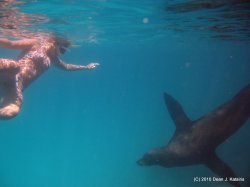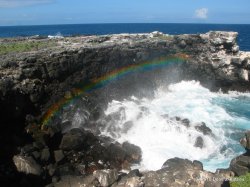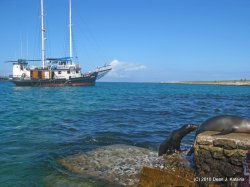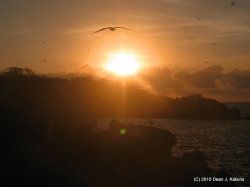Galapagos Goodbye
Monday, April 19, 2010
We were winding down our last days in the Galapagos. Our guide, Enrique, was a super nice and really soft-spoken person and I felt bad that he had to deal with a German guy and a Swiss guy who really had no respect for him and would venture off the trails, snorkel where/when they weren’t supposed to, use flash photography, and so on. They didn’t seem to mind that they put his job on the line every time they did so. The Polish girls, while friendly, were also a bit of a handful in that they would talk when he was talking and interrupt with jokey questions like, “Well how can we know FOR SURE that the rats are vegetarian?” It probably didn’t help that I wasn’t feeling especially well, with a sore throat (crazed air conditioner or snorkel bacteria?) headache and sore muscles. In any case, we had sailed overnight and arrived in Santa Fe island that morning, in a protected bay surrounded by rock. This island is pretty close to Santa Cruz and is popular with day trippers but one advantage of arriving early was that we had it all to ourselves for a few hours. The beach, again, was littered with sea lions and up the path we got a good look at some land iguanas, which, unlike their marine iguana cousins, are not doing so well. Bjorn had observed that up until now whatever our guides had not failed us: whatever they wrote on the board at least one person in the group saw. However, today’s list had an ambitious amount of birds like yellow warblers and a Galapagos hawk not to mention endemic rats, none of which we came across. Still, it had been a pretty good streak. After our short walk we came back on board and went over the side with our snorkelling gear.
 I laid down a bit before heading out with everybody else. So what was the best snorkel for most of the group was just a decent one for me. They saw shark after shark as they got in the water but they had finished their morning snack and gone when I arrived. However, I’m pretty sure I saw (there was no way to miss it) the biggest school of fish I ever have seen or will see. From the surface it looked like rocks because it was a huge patch of black but in the water it was probably millions of black-striped salema, another native fish. I watched a SCUBA diver ‘freefall’ into them very slowly and instead of scattering they slowly opened up a spiralling vortex (widest near the top and closed at the bottom) and as he passed through, closed behind him and swallowed him whole. I did the same, although I couldn’t hold my breath long enough to have them fully cover me and tried to take some photos then a friendly SCUBA diver offered to take my photo. I signalled I was out of air and would come back and he waited for me to catch my breath and plunge down 10m to hand him my camera. Pretty nice! The rest of the snorkel was more tropical fish, a bit of playing with sea lions and amazing blue waters. Because it’s so well protected, the visibility was more than 15m.
I laid down a bit before heading out with everybody else. So what was the best snorkel for most of the group was just a decent one for me. They saw shark after shark as they got in the water but they had finished their morning snack and gone when I arrived. However, I’m pretty sure I saw (there was no way to miss it) the biggest school of fish I ever have seen or will see. From the surface it looked like rocks because it was a huge patch of black but in the water it was probably millions of black-striped salema, another native fish. I watched a SCUBA diver ‘freefall’ into them very slowly and instead of scattering they slowly opened up a spiralling vortex (widest near the top and closed at the bottom) and as he passed through, closed behind him and swallowed him whole. I did the same, although I couldn’t hold my breath long enough to have them fully cover me and tried to take some photos then a friendly SCUBA diver offered to take my photo. I signalled I was out of air and would come back and he waited for me to catch my breath and plunge down 10m to hand him my camera. Pretty nice! The rest of the snorkel was more tropical fish, a bit of playing with sea lions and amazing blue waters. Because it’s so well protected, the visibility was more than 15m.
 From Santa Fe island it was a short haul over lunch to nearby South Plaza, from which you could not only see North Plaza but also Santa Cruz and Gordon Rocks, where I’d SCUBA dove so long ago. This island had some really cool cactus trees, more land iguanas, and yet more cliffs. We also came across a sea lion skeleton bleached white in the sun right beside the decaying remains of a land iguana. Hopefully not a portent for the future. There were plenty of other things to see here, too, but of course we’d seen most of them already. This was becoming a common theme for the second last day of the trip. We drew a bit of a short stick in that, for the third time on our voyage we had to go get more fresh water. Usually that was done the next day, or at least it was when we first boarded and if it had been we would’ve already been flying back to the mainland when that happened. That said, it gave us a really spectacular last evening on board. First we had a really nice dinner and a farewell cocktail, were finally introduced to the crew (strange to do this on the last day instead of the first; I actually knew more of the crew’s names than our guide by now), and then went on deck. First there were flying fish jumping in and out of the water. The sea lions came and would very occasionally sprint after them. For such lazy creatures, I have never seen ANYthing move so fast. Pelicans, of course, were there all along occasionally swooping from their perch on our bow to grab a fish or two.
From Santa Fe island it was a short haul over lunch to nearby South Plaza, from which you could not only see North Plaza but also Santa Cruz and Gordon Rocks, where I’d SCUBA dove so long ago. This island had some really cool cactus trees, more land iguanas, and yet more cliffs. We also came across a sea lion skeleton bleached white in the sun right beside the decaying remains of a land iguana. Hopefully not a portent for the future. There were plenty of other things to see here, too, but of course we’d seen most of them already. This was becoming a common theme for the second last day of the trip. We drew a bit of a short stick in that, for the third time on our voyage we had to go get more fresh water. Usually that was done the next day, or at least it was when we first boarded and if it had been we would’ve already been flying back to the mainland when that happened. That said, it gave us a really spectacular last evening on board. First we had a really nice dinner and a farewell cocktail, were finally introduced to the crew (strange to do this on the last day instead of the first; I actually knew more of the crew’s names than our guide by now), and then went on deck. First there were flying fish jumping in and out of the water. The sea lions came and would very occasionally sprint after them. For such lazy creatures, I have never seen ANYthing move so fast. Pelicans, of course, were there all along occasionally swooping from their perch on our bow to grab a fish or two.
 What had brought us out first though were the Galapagos sharks: there were a few of them circling us. As the sea lions came (the two animals are definitely not friends) the shark numbers escalated. Soon there were around 8, and before we knew it, 20-30 of them. The skeleton we had seen that afternoon was probably from a sea lion that had been fatally wounded in such an encounter as this, so to see them both swimming together was rather tense and we thought at any moment there would be an attack. They’d swim close to each other and usually the sea lion would veer off and the shark might also veer slightly but wouldn’t chase it. Apparently the sea lions are faster in the long run. Then there was once where a sea lion and a shark were swimming a head-on course and as they grew closer everybody came to the one side of the boat. The distance closed at a frustratingly lazy pace and they came nose to nose before each veered in the opposite direction, equally lazy. What was going on here was beyond me. Did the sea lions know the sharks weren’t hungry? Was it a size issue where both shark and sea lion knew that the sea lion was too big for the shark? Still, there were 30 of them, you’d think there would be a fight somewhere but no. It was still cool to watch but I was feeling tired and sick and thought it might be in my best interests to go below although I was SURE as soon as I did I would miss the action. I convinced myself any chase would take the action far from our lights and we’d not see anything, so I said goodnight, told everybody that as soon as I went down they’d see a manta ray (and to thank me in the morning) and went below.
What had brought us out first though were the Galapagos sharks: there were a few of them circling us. As the sea lions came (the two animals are definitely not friends) the shark numbers escalated. Soon there were around 8, and before we knew it, 20-30 of them. The skeleton we had seen that afternoon was probably from a sea lion that had been fatally wounded in such an encounter as this, so to see them both swimming together was rather tense and we thought at any moment there would be an attack. They’d swim close to each other and usually the sea lion would veer off and the shark might also veer slightly but wouldn’t chase it. Apparently the sea lions are faster in the long run. Then there was once where a sea lion and a shark were swimming a head-on course and as they grew closer everybody came to the one side of the boat. The distance closed at a frustratingly lazy pace and they came nose to nose before each veered in the opposite direction, equally lazy. What was going on here was beyond me. Did the sea lions know the sharks weren’t hungry? Was it a size issue where both shark and sea lion knew that the sea lion was too big for the shark? Still, there were 30 of them, you’d think there would be a fight somewhere but no. It was still cool to watch but I was feeling tired and sick and thought it might be in my best interests to go below although I was SURE as soon as I did I would miss the action. I convinced myself any chase would take the action far from our lights and we’d not see anything, so I said goodnight, told everybody that as soon as I went down they’d see a manta ray (and to thank me in the morning) and went below.
 I don’t know if I’ve written it here or not but there are three things I’d really love to see SCUBA diving: whale shark, manta ray, and octopus. And I’d be quite content seeing a Manta Ray from the surface, too, and had made this remark more or less every night. So when I was downstairs, just getting undressed, and Bjorn came downstairs and said “Manta Ray” breathlessly no more than three minutes after I’d said goodnight, I didn’t believe it right away but nonetheless was still zipping up as I stumbled the last few steps onto the deck. He was gone and I was bitter. In the three minutes I’d been below I’d not only missed a Manta Ray swimming by the boat but also, apparently, a bit of a scrap over a fish that a sea lion had caught – the blood of which had brought out a virtual school of sharks. I stayed up there for another half hour but nothing else happened and I went to bed dejected. It was now our final morning and I had not slept well as I had a fever and a bizarre dream in which I read a “children’s book” about a guy going around the world in a flying car that was laced with communist propaganda and words like “Proletariat”. I remember thinking in my dream, “Who on earth is going to read this?” but then the end came and it turned out the book was written by a soldier in World War I and this was HIS dream for the future. So then I woke up and in my fevered state wondered whether I would someday encounter this book and what I would do if I did and couldn’t shut my mind off of that.
I don’t know if I’ve written it here or not but there are three things I’d really love to see SCUBA diving: whale shark, manta ray, and octopus. And I’d be quite content seeing a Manta Ray from the surface, too, and had made this remark more or less every night. So when I was downstairs, just getting undressed, and Bjorn came downstairs and said “Manta Ray” breathlessly no more than three minutes after I’d said goodnight, I didn’t believe it right away but nonetheless was still zipping up as I stumbled the last few steps onto the deck. He was gone and I was bitter. In the three minutes I’d been below I’d not only missed a Manta Ray swimming by the boat but also, apparently, a bit of a scrap over a fish that a sea lion had caught – the blood of which had brought out a virtual school of sharks. I stayed up there for another half hour but nothing else happened and I went to bed dejected. It was now our final morning and I had not slept well as I had a fever and a bizarre dream in which I read a “children’s book” about a guy going around the world in a flying car that was laced with communist propaganda and words like “Proletariat”. I remember thinking in my dream, “Who on earth is going to read this?” but then the end came and it turned out the book was written by a soldier in World War I and this was HIS dream for the future. So then I woke up and in my fevered state wondered whether I would someday encounter this book and what I would do if I did and couldn’t shut my mind off of that.
 But I digress. It was our last morning on the boat and for that matter in the Galapagos. Enrique was waking us up at 5:45 AM to go ashore on North Seymour island and walk around before heading for the airport. I was very seriously considering not going but I dragged myself up and out. It was an important stop for those who were only aboard for 5 days as it was their only chance to see frigate birds, but as you know, I already have plenty of photos of frigate birds not to mention everything else on the island. They were lucky to see a solitary red-footed booby, usually only viewable in Genovesa, and there were still other creatures to photograph including some mating blue-footed boobies, but my camera only came out for the sunrise, a final photo of Angelique, and a photo of a gull and a sea lion together. Not that it wasn’t nice, but how many photos of the same thing can I have? Back on board, I managed to down a pancake and some fruit and then we hauled our stuff up, said our goodbyes, and Enrique brought all but three of us to the airport. A three hour wait and we were on a plane, flying away from the Galapagos as all the many strange species of birds below us had never managed, and on our way to Guyaquil. The plan was to try to get a bus ASAP for Cuenca because Bjorn had only a bit of time left before heading to Europe and I needed to get back on track for making Buenos Aires by July. It went flawlessly. We got off the plane, got our backpacks and walked out the terminal just in time to catch a passing local bus to the bus terminal. At the terminal we got tickets for a bus leaving for Cuenca in ten minutes, just enough time to get upstairs and to the bus, and got it for $6 where the regular price is $8. The man boarding asked where I was from and when I said Canada, he said he’d like to get there someday. Something in the way he said it sounded determined rather than dreamy and I replied that I was sure he would. You’d better believe it, he said, and we were on our way.
But I digress. It was our last morning on the boat and for that matter in the Galapagos. Enrique was waking us up at 5:45 AM to go ashore on North Seymour island and walk around before heading for the airport. I was very seriously considering not going but I dragged myself up and out. It was an important stop for those who were only aboard for 5 days as it was their only chance to see frigate birds, but as you know, I already have plenty of photos of frigate birds not to mention everything else on the island. They were lucky to see a solitary red-footed booby, usually only viewable in Genovesa, and there were still other creatures to photograph including some mating blue-footed boobies, but my camera only came out for the sunrise, a final photo of Angelique, and a photo of a gull and a sea lion together. Not that it wasn’t nice, but how many photos of the same thing can I have? Back on board, I managed to down a pancake and some fruit and then we hauled our stuff up, said our goodbyes, and Enrique brought all but three of us to the airport. A three hour wait and we were on a plane, flying away from the Galapagos as all the many strange species of birds below us had never managed, and on our way to Guyaquil. The plan was to try to get a bus ASAP for Cuenca because Bjorn had only a bit of time left before heading to Europe and I needed to get back on track for making Buenos Aires by July. It went flawlessly. We got off the plane, got our backpacks and walked out the terminal just in time to catch a passing local bus to the bus terminal. At the terminal we got tickets for a bus leaving for Cuenca in ten minutes, just enough time to get upstairs and to the bus, and got it for $6 where the regular price is $8. The man boarding asked where I was from and when I said Canada, he said he’d like to get there someday. Something in the way he said it sounded determined rather than dreamy and I replied that I was sure he would. You’d better believe it, he said, and we were on our way.
Photos Read More...

No comments:
Post a Comment